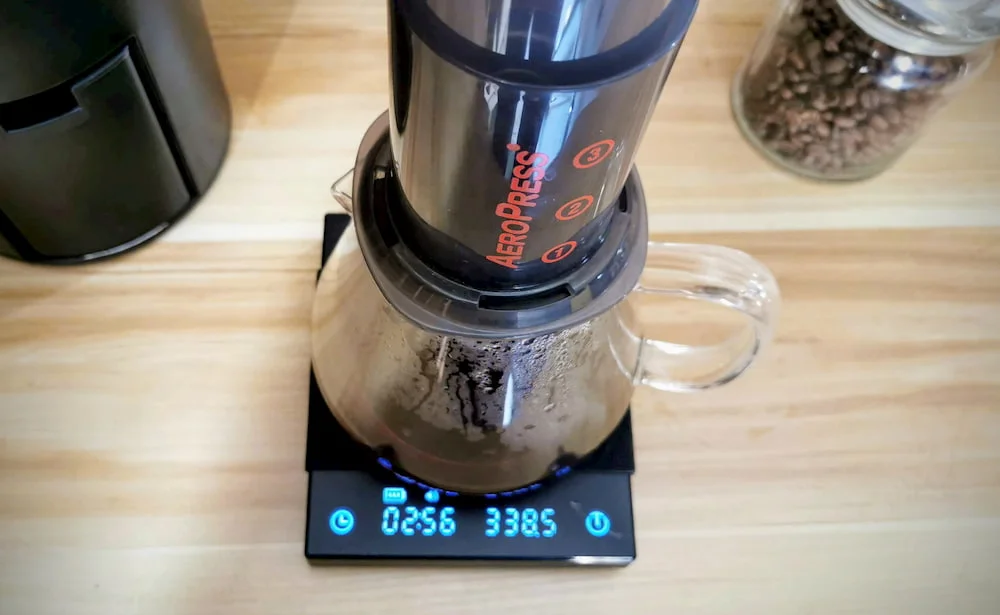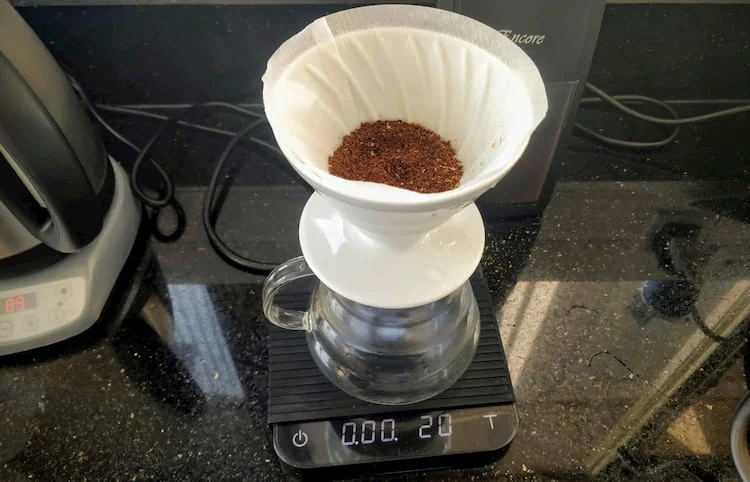AeroPress and pour over are two of the most beloved coffee brewing methods out there.
The AeroPress was invented in 2005 – and as they say; the rest is history.
Pour over started to get traction a few years later when the Hario V60 was introduced in the Western world.
In this article, we’ll take a close look at the two brewing methods and discuss their pros and cons before ultimately revealing which one we prefer.
Are you ready to rumble? Because some undisputed coffee champs are about to face off.
Percolation vs Immersion
The first thing to keep in mind when discussing these two champions of manual coffee brewing is that they rely on two very different principles when it comes to brewing.
Immersion
This coffee brewer mainly relies on immersion; in layman’s talk, the coffee is extracted by steeping with the water. However, the AeroPress is a bit of a hybrid since part of the extraction also relies on air pressure.
Traditionally, immersion was seen as a less efficient brewing method compared to pour over coffee; however, due to its unique design, the AeroPress can often extract more than most other methods.
If we get a bit geeky, this is allowed because there is almost no water bypass. Also, the “liquid retained ratio” is a lot lower with the AeroPress compared to something like French press.
All in all, this hybrid method packs a punch in a versus battle like this.


Percolation
When you keep pouring water over coffee grounds, you engage in what is known as “percolation.” This brewing method is handy since you keep introducing fresh water, which will act as a powerful solvent. It also means that the water stuck in the slurry/coffee grounds is getting weaker and weaker. This means that pour over is a surprisingly efficient brewing method.
Winner: Even though pour over is an efficient brewing method, it can’t keep up with the efficiency of the AeroPress. This brewer is highly versatile, and the combination of steeping and pressure is more or less unique.
Read More: AeroPress vs French Press
Volume
It’s always nice to be able to brew a humongous batch of coffee. So can we achieve that with any of our contenders?
Pour over is quite capable of brewing larger batches. First, of course, one must remember that pour over is a close cousin to the drip coffee maker. So it runs in the family. With many pour over gadgets, you’ll have no problem making 2-6 cups of coffee at a time.
If you buy one of the special drippers – such as the relatively rare Hario V60 #3 – you can even make even bigger batches.
The AeroPress is a lot more limited when it comes to volume. It’s incredible for single-serve coffee, but going beyond that is challenging. As a result, many people resort to using the bypass technique for bigger batches. However, I have developed a method that lets you brew two cups of AeroPress at the same time. It’s an excellent technique if I’m allowed to say that!
Winner: Pour over takes this one without breaking a sweat! Aeropress is limited to two cups maximum.
Read More: AeroPress vs Chemex

Portability / sturdiness for travel
The AeroPress is a favorite travel companion among coffee snobs. It’s not because the device is lighter or more sturdy compared to a pour over dripper. The main reason is that it’s straightforward to use the brewer without other barista tools – like, for example, a gooseneck kettle and scale.
This travel-friendliness is even more pronounced now that the AeroPress Go has been released.
However, pour over coffee makers aren’t just going to roll over here. A gadget like the plastic Hario V60 is light and sturdy. Or you could even consider the Munieq Tetra Drip, which is about the same size and weight as a CD-Rom. Some pour over devices are excellent for life on the road.
Winner: I think we have to call this a draw. And that’s only fair. I always bring both an AeroPress and pour over dripper whenever I travel.
Ease of use
The AeroPress is easy to use but hard to master. The devil is in the details with this brewer. There are so many recipes out there, so it’s easy to be confused.
The Hario V60 might require a gooseneck kettle and a little bit of patience. But my gut feeling is that it’s easier to achieve “almost barista level” coffee with a pour over brewer.
Winner: It might be a controversial call, but I’m going to give this one the pour over camp.

Flavor
You can make every kind of coffee with an AeroPress. From a concentrated espresso-style shot to a regular cuppa Joe. When an AeroPress coffee is delicious, it’s a thing of beauty.
On the other hand, pour over coffee tends to be more elegant and silky. It seems like the clarity is higher, acidity is more well-defined, and the aftertaste smoother.
Winner: Again, it’s a draw. Both methods can produce perfect cups. However, my instinct tells me that it happens more often with a pour over brewer.
AeroPress vs Pour Over: The Verdict
It was a close call, but overall, pour over emerges as the winner in this battle.
Luckily, you don’t have to stick with a single brew method. Most home baristas end up having enough room for both a pour over cone and an AeroPress.


